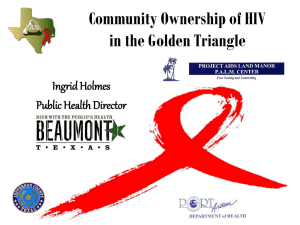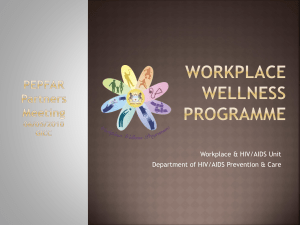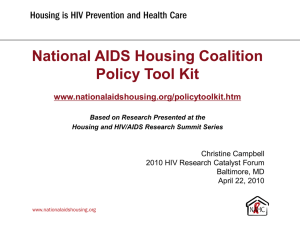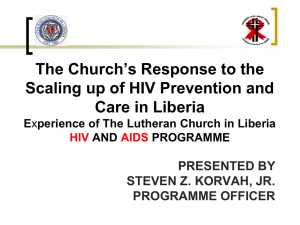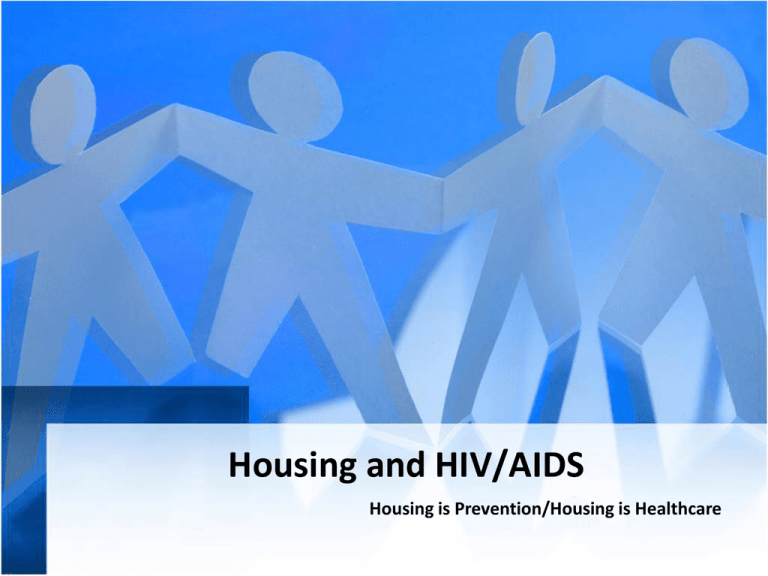
Housing and HIV/AIDS
Housing is Prevention/Housing is Healthcare
Housing and HIV/AIDS
“It would seem like a no-brainer to me that you need
a roof over your head to maintain your health.”
Cassandra Ackerman
HIV/AIDS Consumer Advocate &
NAHC Board Member
Housing is HIV Prevention
Housing provides a strategic point of intervention
• Over time, studies show a strong association between
change in housing status and risk behavior change
• Over time, persons who improved housing status reduced
risk behaviors by half; while persons whose housing status
worsened over time were 4 times as likely to exchange sex
for money, food, drugs or housing.
• Access to housing also increases access to appropriate care
and antiretroviral medications which lower viral load,
reducing the risk of transmission.
Unstable housing adds to HIV risk
• Rates of HIV infection are 3 -16 x higher among persons who are
homeless or unstably housed compared to similar persons with stable
housing
• 3% to 14% of all homeless persons are HIV positive (10 times the rate
in the general population)
• Over time studies show that among persons at high risk for HIV
infection due to injecting drug use or risky sex, those without a stable
home are more likely than others to become infected
• Harm reduction or other prevention interventions are much less
effective for participants struggling with housing issues
HIV infection- A Major Risk Factor for Housing Loss
• Up to 50% of all PLWHA report a lifetime experience of
homelessness or housing instability
• 10% to 16% of all diagnosed PLWHA are literally homeless
- sleeping in shelters, on the street, in a car, or in an
encampment
• Twice as many have housing problems, experience housing
insecurity or threat of housing loss
• Rates of housing need remain high – as some persons get
their housing needs met, others develop housing problems
Housing & Risk Behaviors
• Research shows a direct relationship between housing
status and risk behaviors
• Homeless or unstably housed persons were 2 to 6 X more
likely to use hard drugs, share needles or exchange sex
than stably housed persons with the same risk group,
demographic, health, and service use characteristics
• There is an apparent “dose-relationship” with the homeless
at greater risk than the unstably housed, and both of these
groups at greater risk than the stably housed
Housing and Health Outcomes
• High viral load, recent opportunistic infection, and
hospitalization for HIV related disease are associated with
homelessness/ unstable housing
• Homeless/unstably housed PLWHA have higher rates HCV, other
co-morbidities
• Mortality studies: All-cause death rate among homeless PLWHA
is 5 X the death rate for housed PLWHA
• Among homeless, death rate due to HIV/AIDS is 7 - 9 X the
death rate due to HIV/AIDS among the general population
Summary
• HIV positive persons with unstable housing are more likely to engage in
sex and drug risk behaviors, are less likely to be engaged in appropriate
medical care
• Overtime analyses show improvement in housing situation is
associated with reduction in risk behaviors and positive change in
medical care outcomes
• Findings suggest that the condition of homelessness/unstable housing,
and not simply traits of individuals with housing problems, influences
risk behaviors and connection to HIV medical care
• Provision of housing is a promising structural intervention to reduce
the spread of HIV as well as improve the lives of infected persons
CHHP preliminary results show housing
saves lives & money
• Preliminary data indicate 70% of clients provided housing were housed
at 18 months, compared to only 15% of the “usual care” group.
• Housed participants remained stable despite high rates of mental
illness (46%), substance use (86%) & other factors thought to affect
ability to stay housed.
• Housed group used half as many nursing home days as usual care
counterparts & were nearly two times less likely to be hospitalized or
use ER
• $12,000 average annual cost of supportive housing & coordinated care
• Preliminary cost estimates show annual medical expenses for housed
group may be at least $900,000 less than usual care group, after
subtracting the costs of housing intervention
H&H Preliminary Results: Housing = Health
Significant improvements in housing status in both “intervention” and
“customary care” study arms at 18 months
– 82% of voucher recipients stably housed - up from 4% at baseline
– 52% of control group stably housed - up from 4% at baseline
Significantly, as housing improved for the group as a whole, so did health
outcomes, including:
–
–
–
–
–
34% reduction in emergency room visits
21% reduction in hospitalizations
44% reduction in reported opportunistic infections
40% reduction in sex trade
Significant improvement in mental health status
HIV and Homelessness
In 2007:
• 455,636 persons living with AIDS in the United States. In the 34 states
that report HIV, 571,378 persons were HIV infected.
• According to the CDC, 56,000 people became infected with HIV in 2006
in the U.S., a 40% increase than previous estimates.
• 216,624 people with HIV/AIDS with incomes of 30% of area median
income or less are in need of housing assistance.
The National Alliance to End Homelessness estimates that without the
infusion of $1.5 billion for homelessness prevention and rapid rehousing included in the American Reform and Recovery Act, an
approximately 1.5 million additional Americans will become homeless
in 2009 and 2010.
HIV/AIDS in CT
As of December 31, 2009:
• 10,574 people are reported living with HIV/AIDS.
• DPH estimates that approximately 13,385 people
are infected in Connecticut.
• In 2009 18% of newly reported HIV infections in
Connecticut occurred in people between the ages
of 13 -29.
HIV/AIDS in CT
•
HIV/AIDS cases continue to be diagnosed at higher
rates in Blacks and Hispanics (67%)
Sexually active young people do not get routinely
tested for HIV. This means most of them were
infected in their teens or early twenties.
African-American men are 30.9 times more likely
to die from AIDS
Latino men are 20.4 times more likely to die from AIDS.
AIDS Housing in CT
•Since the first program opened its doors in the mid-1980s,
the agencies have housed thousands of men, women and
children who otherwise would have been homeless.
•Some are actual houses, others are independent apartments,
some care for the physically fragile while others care for the
socially fragile.
•Each has its own personality and characteristics, but all strive
to ensure that persons living with AIDS are provided with the
highest quality housing and support services available.
Demand for and Utilization of
AIDS Housing
In 2009:
• The 27 AIDS housing programs provided housing and
support to 1,300 men, women and children.
• 95% of the 2,500 people requesting housing were turned
away.
• The Point in Time Count of people who are homeless, 6%
reported as having HIV/AIDS, and in Hartford and New
Haven the percentage was 15% and 8%, respectively. Due
to self-reporting, it’s likely that these figures are, in reality,
much higher.
Barriers to affordable, supportive housing
•
•
•
•
•
•
Long waiting lists for affordable housing, including rent
subsidies.
In CT, nearly 50,000 people applied for less than 1,500
AVAILABLE rent subsidies.
Low vacancy rates.
Unrealistic FMRs.
Lack of assistance in finding housing, transportation and
childcare.
Source of income and other forms of discrimination.
Funding Sources for AIDS Housing
Federal
• The Obama administration's proposed HOPWA budget for
2011 is $340 million, a $5 million increase over last year
• NAHC strongly recommends that HOPWA be funded at $410
million in FY11
• CT receives 4 “pots” of HOPWA funds:
- Hartford EMA
- New Haven EMA
- Bridgeport EMA (Fairfield County)
- Balance of State
State Funding
State Funding
• In the Department of Social Services budget, the State of CT currently
has $ allocated to “Residences for Persons with AIDS”. The
breakdown of those funds is:
$ state dollars $4.187 m
$ TANF/SSBG dollars $861,555
• In CT, combined with HOPWA funds, there is nearly $7 million dollars in
funds dedicated to housing for people with HIV/AIDS
• In 2008, we were able to get an increase of $750,000 which allowed the
addition of over 50 new units of housing in un- or underserved areas of
the state.
AIDS Housing in CT
CT AIDS Housing Directory
http://www.ctaidscoalition.org/guide.htm
CSH Housing Resource Directory
http://www.csh.org/index.cfm?fuseaction=Page.viewPage&pa
geID=763
CT AIDS Resource Coalition
For more information:
Shawn M. Lang
Director of Public Policy
CT AIDS Resource Coalition
860.761.6699
shawn@ctaidscoalition.org
Thanks to the National AIDS Housing Coalition’s Policy
Toolkits for this information



